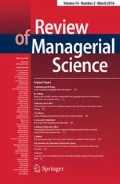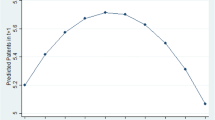Abstract
Sustaining success requires the integration of the contradicting aims of short-term efficiency and long-term innovation. Coupling exploitation and exploration is therefore a major challenge for organizations. Small and medium-sized enterprises (SME) suffer particularly from resource constraints for nurturing both learning modes concurrently. In this paper, we draw on empirical case-study evidence of a globally operating SME to show how managing the interplay of organizational structure and context enables firms to combine exploration and exploitation for achieving ambidexterity. Our findings show that creating ambidexterity requires firms to manage different tensions on multiple levels. In particular, we distinguish between the learning dimension and the flexibility dimension of ambidexterity. The learning dimension refers to balancing incremental and radical innovations, while the flexibility dimension refers to balancing alignment and adaptability in terms of a firm’s organizational design. Both dimensions have to be balanced simultaneously to create organizational ambidexterity. We show how the creation of a common frame of reference enables the behavioral integration of exploration and exploitation and the formation of knowledge bridges at multiple levels of the organization in a structurally ambidextrous firm. Further, our findings suggest that dealing with tensions between incremental/radical innovation and adaptability/alignment refers to managing a “second-order”-balance between exploration and exploitation.



Similar content being viewed by others
References
Abernathy WJ (1978) The productivity dilemma roadblock to innovation in the automobile industry. Johns Hopkins University Press, Baltimore
Adler PS, Goldoftas B, Levine D (1999) Flexibility versus efficiency? A case study of model changeovers in the Toyota production system. Organ Sci 10:43–68
Adler PS, Benner M, Brunner DJ, MacDuffie JP, Osono E, Staats BR, Takeuchi H, Tushman ML, Winter SG (2008) Perspectives on the productivity dilemma. J Oper Manag 27:99–113
Andriopoulos C, Lewis MW (2009) Exploitation-exploration tensions and organizational ambidexterity: managing paradoxes of innovation. Organ Sci 20:696–717
Argote L (1999) Organizational learning: creating, retaining and transferring knowledge. Springer, Norwell, MA
Baden-Fuller C, Winter SG (2005) Replicating organizational knowledge: principles or templates?. Jena: Max Planck Institute of Economics/Evolutionary Economics Group. Papers on Economics and Evolution: 1–40
Benner MJ, Tushman ML (2002) Process management and technological innovation: a longitudinal study of the photography and paint industries. Adm Sci Q 47:676–706
Benner MJ, Tushman ML (2003) Exploration, exploitation, and process management: the productivity dilemma revisited. Acad Manag Rev 28:238–256
Bradach J (1997) Using the plural form of management of restaurants chains. Adm Sci Q 42:276–303
Brown SL, Eisenhardt KM (1997) The art of continuous change: linking complexity theory and time-paced evolution in relentlessly shifting organizations. Adm Sci Q 42:1–34
Cao Q, Gedajlovic E, Zhang H (2009) Unpacking organizational ambidexterity: dimensions, contingencies, and synergistic effects. Organ Sci 20:781–796
Chesbrough H, Rosenbloom RS (2002) The role of the business model in capturing value from innovation: evidence from Xerox Corporation’s technology spin-off companies. Ind Corp Change 11:529–555
Christensen CM (1997) The innovator’s dilemma: when new technologies cause great firms to fail. Harvard Business School Press, Boston (MA)
Combs JG, Michael SC, Castrogiovanni GJ (2004) Franchising: a review and avenues to greater theoretical diversity. J Manag 30:907–931
Creswell JW (2007) Qualitative inquiry and research design, 2nd edn. Sage, Thousand Oaks, London, New Delhi
Daft RL, Weick KE (1984) Toward a model of organizations as interpretation systems. Acad Manag Rev 9:284–295
Eggers JP, Kaplan S (2013) Cognition and capabilities: a multi-level perspective. Acad Manag Ann 7:293–338
Eisenhardt KM (1989) Building theories from case study research. Acad Manag Rev 14:532–550
Eisenhardt KM, Graebner M (2007) Theory building from cases: opportunities and challenges. Acad Manag J 50:25–32
Eisenhardt KM, Furr NR, Bingham CB (2010) Microfoundations of performance: balancing efficiency and flexibility in dynamic environments. Organ Sci 21:1263–1273
Flick U, von Kardorff E, Steinke I (2004) A companion to qualitative research. Sage, London
Frank H, Güttel WH, Weismeier-Sammer D (2010) Ambidexterity in Familienunternehmen—Die Top-Management-Familie als Innovationsinkubator. Managementforschung 20:183–222
Froschauer U, Lueger M (2003) Das qualitative interview. WUV, Wien
Gibson CB, Birkinshaw J (2004) The antecedents, consequences, and mediating role of organizational ambidexterity. Acad Manag J 47:209–226
Gilbert CG (2005) Unbundling the structure of inertia: resource versus routine rigidity. Acad Manag J 48:741–763
Gilbert CG (2006) Change in the presence of residual fit: can competing frames coexist? Organ Sci 17:150–167
Gupta AK, Smith KG, Shalley CE (2006) The interplay between exploration and exploitation. Acad Manag J 49:693–706
Güttel WH, Konlechner S (2009) Continuously hanging by a thread: dynamic capabilities in ambidextrous organizations. Schmalenbach Bus Rev 61:150–172
Güttel WH, Konlechner S, Müller B, Trede J, Lehrer M (2012) facilitating ambidexterity in replicator organizations: artifacts in their role as routine-recreators. Schmalenbach Bus Rev 64:187–203
Harvey J, Pettigrew A, Ferlie E (2002) The determinants of research group performance: towards mode 2. J Manag Stud 39:747–774
He Z-L, Wong P-K (2004) Exploration vs. exploitation: an empirical test of the ambidexterity hypothesis. Organ Sci 15:481–494
Holmqvist M (2004) Experiential learning processes of exploitation and exploration within and between organizations: an empirical study of product development. Organ Sci 15:70–81
Inkpen AC, Tsang EWK (2005) Social capital, networks, and knowledge transfer. Acad Manag Rev 30:146–165
Jansen JJP, George G, Van den Bosch FAJ, Volberda HW (2008) Senior team attributes and organizational ambidexterity: the moderating role of transformational leadership. J Manag Stud 45:982–1007
Jansen JJP, Tempelaar MP, Van den Bosch FAJ, Volberda HW (2009) Structural differentiation and ambidexterity: the mediating role of integration mechanisms. Organ Sci 20:797–811
Jick TD (1979) Mixing qualitative and quantitative methods: triangulation in action. Adm Sci Q 24:602–611
Kraus S, Harms R, Fink M (2011) Family firm research: sketching a research field. Int J Entrep Innov Manag 13:32–47
Kraus S, Pohjola M, Koponen A (2012) Innovation in family firms: an empirical analysis linking organizational and managerial innovation to corporate success. Rev Manag Sci 6:265–286
Lavie D, Stettner U, Tushman M (2010) Exploration and exploitation within and across organizations. Acad Manag Ann 4:109–155
Leonard-Barton D (1992) Core capabilities and core rigidities: a paradox in managing new product development. Strateg Manag J 13:111–125
Levinthal DA, March JG (1993) The myopia of learning. Strateg Manag J 14:95–112
Lubatkin MH, Simsek Z, Ling Y, Veiga JF (2006) Ambidexterity and performance in small-to-medium-sized firms: the pivotal role of top management team behavioral integration. J Manag 32:646–672
Ludwig R (2008) Schmuck-Design der Moderne—Modern Jewellery Design. Arnoldsche, Stuttgart 2008
March JG (1991) Exploration and exploitation in organizational learning. Organ Sci 2:71–87
Miles M, Huberman M (1994) Qualitative data analysis: an expanded sourcebook, 2nd edn. Sage, Thousand Oaks, CA
Mom TJM, Van Den Bosch FAJ, Volberda HW (2007) Investigating managers’ exploration and exploitation activities: the influence of top-down, bottom-up, and horizontal knowledge inflows. J Manag Stud 44:910–931
Mom TJM, Van den Bosch FAJ, Volberda HW (2009) Understanding variation in managers’ ambidexterity: investigating direct and interaction effects of formal structural and personal coordination mechanisms. Organ Sci 20:812–828
O’Reilly CA, Harreld JB, Tushman ML (2009) Organizational ambidexterity: IBM and emerging business opportunities. Calif Manag Rev 51:75–99
O’Reilly CA, Tushman ML (2008) Ambidexterity as a dynamic capability: resolving the innovator’s dilemma. Res Organ Behav 28:185–206
Raisch S (2008) Balanced structures: designing organizations for profitable growth. Long Range Plann 41:483–508
Raisch S, Birkinshaw J (2008) Organizational ambidexterity: antecedents, outcomes, and moderators. J Manag 34:375–409
Raisch S, Birkinshaw J, Probst G, Tushman ML (2009) Organizational ambidexterity: balancing exploitation and exploration for sustained performance. Organ Sci 20:685–695
Rothaermel FT, Deeds DL (2004) Exploration and exploitation alliances in biotechnology: a system of new product development. Strateg Manag J 25:201–221
Sanchez R, Mahoney J (1996) Modularity, flexibility, and knowledge management in product and organization design. Strateg Manag J 17:63–76
Sidhu JS, Commandeur HR, Volberda HW (2007) The multifaceted nature of exploration and exploitation: value of supply, demand, and spatial search for innovation. Organ Sci 18:20–38
Siggelkow N (2007) Persuasion with case studies. Acad Manag J 50:20–24
Simsek Z, Heavey C, Veiga JF, Souder D (2009) A typology for aligning organizational ambidexterity’s conceptualizations, antecedents, and outcomes. J Manag Stud 46:864–894
Smith WK, Tushman ML (2005) Managing strategic contradictions: a top management model for managing innovation streams. Organ Sci 16:522–536
Tripsas M, Gavetti G (2000) Capabilities, cognition, and inertia: evidence from digital imaging. Strateg Manag J 21:1147–1162
Turner N, Swart J, Maylor H (2012) Mechanisms for managing ambidexterity: a review and research agenda. Int J Manag Res 15:317–332
Tushman ML, O’Reilly CA (1996) Ambidextrous organizations: managing evolutionary and revolutionary change. Calif Manag Rev 38:8–30
Winter SG (1995) Four Rs of Profitability: Rents, Resources, Routines, and Replication. In: Montgomery C (ed) Resource-based and Evolutionary theories of the firm: towards a synthesis. Boston (MA), pp 147–178
Winter SG, Szulanski G (2001) Replication as Strategy. Organ Sci 12:730–743
Yin RK (2003) Case study research: design and methods, 3rd edn. Sage, Newbury Park, CA
Acknowledgments
The helpful comments of Catherine Gundolf and two anonymous reviewers are gratefully acknowledged. Financial support was graciously provided by funds of the Oesterreichische Nationalbank (Anniversary Fund, project number: 13798).
Author information
Authors and Affiliations
Corresponding author
Rights and permissions
About this article
Cite this article
Güttel, W.H., Konlechner, S.W. & Trede, J.K. Standardized individuality versus individualized standardization: the role of the context in structurally ambidextrous organizations. Rev Manag Sci 9, 261–284 (2015). https://doi.org/10.1007/s11846-014-0156-2
Received:
Accepted:
Published:
Issue Date:
DOI: https://doi.org/10.1007/s11846-014-0156-2




